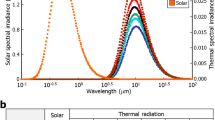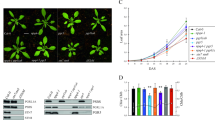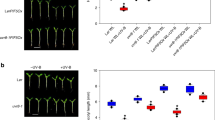Abstract
MANY aspects of plant development are subject to photocontrol by way of the chromoprotein photoreceptor phytochrome. Phytochrome exists in two forms, Pr, which absorbs maximally at 660 nm, and Pfr, which absorbs maximally at 725–735 nm1,2. Absorption of light by either form results in phototransformation to the isomeric form. These properties make phytochrome a unique photoreceptor and raise important questions concerning the function of phytochrome in plants growing in the natural environment3,4. In the physiological experiments which have been so successful in elucidating the details of the structure and properties of the molecule, and which are beginning to provide evidence on its cellular mode of action, aetiolated plants are usually used and are given abnormal irradiation treatments involving brief or prolonged exposure to radiation of restricted wavelengths. Such conditions do not occur in the natural environment and, therefore, such experiments provide no evidence on the role of phytochrome in plants growing in the field. Suggestions have been made that phytochrome may enable the plant to detect shading by other plants and thus induce the alteration of metabolism and development in an appropriate manner5,6. These proposals point out that radiant energy below 700 nm is almost completely reflected or absorbed by vegetation, whilst that between 700–800 nm (that is, the far red) is largely transmitted7–10. The relative enhancement of the far red will presumably alter the photoequilibrium of Pr Pfr in plants growing under vegetation canopies, presenting a possible mechanism for the detection of shading. No systematic attempts have yet been made, however, to determine the extent of the spectral energy changes in the natural environment, to correlate them with effects on phytochrome photoequilibria and to assess the possible regulatory role of phytochrome under these conditions. In this report we present preliminary evidence along these lines which is consistent with the above hypothesis.
Pfr in plants growing under vegetation canopies, presenting a possible mechanism for the detection of shading. No systematic attempts have yet been made, however, to determine the extent of the spectral energy changes in the natural environment, to correlate them with effects on phytochrome photoequilibria and to assess the possible regulatory role of phytochrome under these conditions. In this report we present preliminary evidence along these lines which is consistent with the above hypothesis.
This is a preview of subscription content, access via your institution
Access options
Subscribe to this journal
Receive 51 print issues and online access
$199.00 per year
only $3.90 per issue
Buy this article
- Purchase on Springer Link
- Instant access to full article PDF
Prices may be subject to local taxes which are calculated during checkout
Similar content being viewed by others
References
Hillman, W. S., A. Rev. Pl. Physiol., 18, 301–324 (1967).
Briggs, W. R., and Rice, H. V., A. Rev. Pl. Physiol., 23, 293–334 (1972).
Shropshire, W., Solar Energy, 15, 99–105 (1973).
Smith, H., in Seed Ecology (edit. by Heydecker, W.), 219–231 (Butterworths, London, 1973).
Taylorson, R. B., and Borthwick, H. A., Weed Sci., 17, 48–51 (1969).
Cumming, B. G., Can. J. Bot., 41, 1211–1233 (1963).
Woolley, J. T., Pl. Physiol., Lancaster, 47, 656–662 (1971).
Kasperbauer, M. J., Pl. Physiol., Lancaster, 47, 775–778 (1971).
Stoutjesdijk, P. H., Acta Bot. Neerl., 21, 185–191 (1972).
Federer, C. A., and Tanner, C. B., Ecology, 47, 555–560 (1966).
Hillman, W. S., Physiologia. Pl., 18, 346–358 (1965).
Kendrick, R. E., and Frankland, B., Planta, 82, 317–320 (1968).
Mumford, F. E., and Jenner, E. L., Biochemistry, 10, 90–101 (1971).
Kendrick, R. E., and Spruit, C. J. P., Planta, 107, 341–350 (1972).
Author information
Authors and Affiliations
Additional information
The erratum article can be found online at https://doi.org/10.1038/256072a0
Rights and permissions
About this article
Cite this article
HOLMES, M., SMITH, H. The function of phytochrome in plants growing in the natural environment. Nature 254, 512–514 (1975). https://doi.org/10.1038/254512a0
Received:
Published:
Issue Date:
DOI: https://doi.org/10.1038/254512a0
This article is cited by
-
Molecular basis of flowering under natural long-day conditions in Arabidopsis
Nature Plants (2018)
-
Blue light advances bud burst in branches of three deciduous tree species under short-day conditions
Trees (2018)
-
Population structure and association mapping of traits related to reproductive development in field pea
Euphytica (2017)
-
Aboveground growth interactions of paired conifer seedlings in close proximity
New Forests (2011)
-
Germination Requirement of Vallisneria natans Seeds: Implications for Restoration in Chinese Lakes
Hydrobiologia (2006)
Comments
By submitting a comment you agree to abide by our Terms and Community Guidelines. If you find something abusive or that does not comply with our terms or guidelines please flag it as inappropriate.



